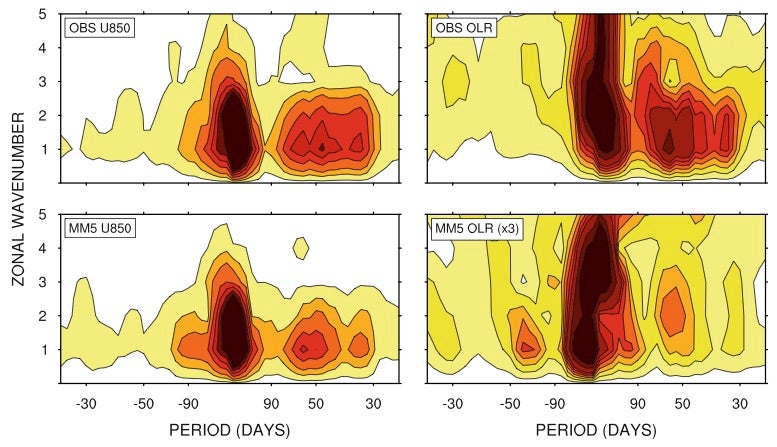
Abstract
The Madden–Julian oscillation (MJO) produced by a mesoscale model is investigated using standardized statistical diagnostics. Results show that upper- and lower-level zonal winds display the correct MJO structure, phase speed (8 m/s) and space–time power spectrum. However, the simulated free atmosphere moisture, outgoing longwave radiation and precipitation do not exhibit any clear MJO signal. Yet, the boundary layer moisture, moist static energy and atmospheric instability, measured using a moist static energy instability index, have clear MJO signals. A significant finding is the ability of the model to simulate a realistic MJO phase speed in the winds without reproducing the MJO wind-convection coupling or a realistic propagation in the free atmosphere water vapor. This study suggests that the convergence of boundary layer moisture and the discharge and recharge of the moist static energy and atmospheric instability may be responsible for controlling the speed of propagation of the MJO circulation.
Links
BibTeX (Download)
@article{monier2010madden,
title = {The Madden-Julian oscillation wind-convection coupling and the role of moisture processes in the MM5 model},
author = {E Monier and BC Weare and WI Gustafson},
doi = {10.1007/s00382-009-0626-4},
year = {2010},
date = {2010-07-24},
journal = {Climate Dynamics},
volume = {35},
number = {2-3},
pages = {435--447},
publisher = {Springer},
abstract = {The Madden–Julian oscillation (MJO) produced by a mesoscale model is investigated using standardized statistical diagnostics. Results show that upper- and lower-level zonal winds display the correct MJO structure, phase speed (8 m/s) and space–time power spectrum. However, the simulated free atmosphere moisture, outgoing longwave radiation and precipitation do not exhibit any clear MJO signal. Yet, the boundary layer moisture, moist static energy and atmospheric instability, measured using a moist static energy instability index, have clear MJO signals. A significant finding is the ability of the model to simulate a realistic MJO phase speed in the winds without reproducing the MJO wind-convection coupling or a realistic propagation in the free atmosphere water vapor. This study suggests that the convergence of boundary layer moisture and the discharge and recharge of the moist static energy and atmospheric instability may be responsible for controlling the speed of propagation of the MJO circulation.},
keywords = {},
pubstate = {published},
tppubtype = {article}
}